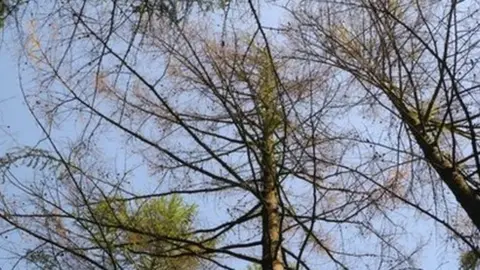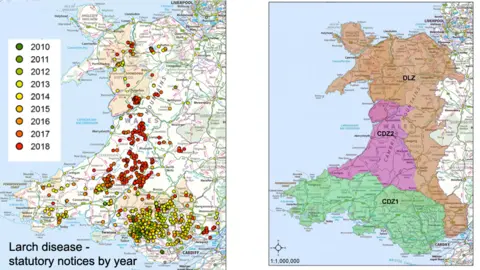New efforts to stop larch disease in Wales
 PA
PANew efforts to tackle the rapid spread of larch disease have been announced by the Welsh Government.
The fungal disease, phytophthora ramorum, causes fatal lesions on tree trunks and emerged in Wales in 2010.
It has spread into parts of mid and west Wales.
A "refreshed strategy" includes aerial surveys to try to stop it spreading into northern and eastern Wales, where landowners will be expected to act quickly if it is found.
The disease is spread by spores released from infected trees and has advanced rapidly since it emerged in the Afan valley in 2010.
Across Wales, areas covered by statutory notices for infected larch span the equivalent of about 11,000 rugby pitches.
The updated strategy said it had become "clear that both the disease situation and our understanding of the disease had significantly changed since the strategy was produced in 2014".
 Crown copyright/Welsh Government
Crown copyright/Welsh GovernmentMaps have now been redrawn for tackling the disease and Wales has been broken down into three zones:
- Core disease zone 1 (CDZ1) is where most of the early cases were concentrated. It is estimated that statutory notices have already been issued to the majority of larch woodlands within this area
- Most of mid Wales lies in the second core disease zone (CDZ2), where aerial surveys will concentrate mainly on areas bordering a third, largely unaffected zone
- The disease limitation zone (DLZ) has limited infection and the aim is to slow the rate. If disease is found, landowners will be expected to harvest or destroy the trees within a target time
Environment Minister Lesley Griffiths said: "We recognise pests, pathogens and invasive non-native species have significant potential to impact on the health of trees and woodlands in Wales.
"The refreshed strategy will play a key role in minimising the social, environmental and economic impacts of P.ramorum in the CDZ2 area whilst maintaining our commitment to managing the spread of the disease."
